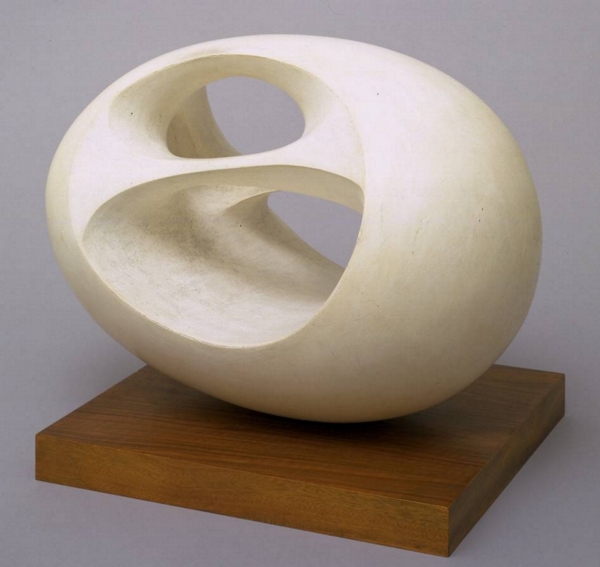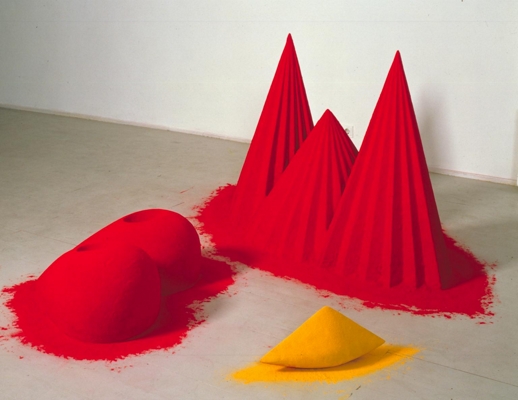This post is part of a series of blog posts called Noteworthy Artists and
Artworks. For more information about the series, please read Series Breakdown:
Noteworthy Artists and Artworks. You can find the link at the end of this page.
For this post, I will focus on two artists: Barbara Hepworth and Anish
Kapoor. The works I will spend my time discussing here are Oval Sculpture
(No. 2) by Hepworth and As if to Celebrate I Discovered a Mountain Blooming
with Red Flowers by Kapoor. Throughout this post, I will explain how my
understanding of mass, volume, location, positioning, surface and traversing
space have been influenced by them.
Before continuing, I would like to add a quick note. At the time of writing, you
will find only one sculpture in my body of work. This does not mean I do not
think in sculptural terms. If given the opportunity, I would focus more of my
time making sculptures. The reason I do not is because I do not have the space
to do so (storage or work). What this means is there is a less immediate mapping
between the works discussed and mine. Thus, my general thoughts and observations
will be my main focus and not direct examples of the topics discussed in my
work.
 Figure 1: Oval Sculpture (No. 2), 1943 (cast in 1958) by Barbara Hepworth.
Figure 1: Oval Sculpture (No. 2), 1943 (cast in 1958) by Barbara Hepworth.
I will begin by looking at Oval Sculpture (No. 2) (fig. 1), by Barbara
Hepworth. If you are unfamiliar with her and this piece, here is a quick
summary. She was born in Wakefield, U.K. on the 10th January, 1903 and died 20th
May 1975. Hepworth was known most of all for her sculptural work, but she did
work in other media. Oval Sculpture (No. 2) (fig. 1) was completed in 1943 and
cast in 1958. Tate acquired it in 1967 and it has been part of its collection
ever since.
One of the most notable aspects of this sculpture is how shapely it
is. Physically speaking, it appears solid and to be carrying a fair amount of
weight. Upon closer inspection, the “holes” seem to be misleading. They appear
to be as confident as the form itself. And, in a sort of contradicting manner,
they act as non-physical physical members of the mass. One could argue, this is
an effective example of negative space.
The non–physical aspect of this piece has made it easier to pierce the surface
and traverse within the solid matter – conceptually speaking. This is a nice
visual and mental sensation in and of itself. With that said, I think the more
important point here (for me at least) is it has helped train me to view
mass/volume as a way to define space – and not just consume it.
A key feature of a surface is its ability to act as a barrier, separating the
inside from the outside. With that said, what the empty space has done is force
me to reconsider what I mean when I say/think “inside and outside”. Please
consider the image below to help explain my point.
 Figure 2: Hepworth has managed to weave a duality between what is considered "inside" and "outside" the piece.
Figure 2: Hepworth has managed to weave a duality between what is considered "inside" and "outside" the piece.
What the image (fig. 2) highlights is how the empty space (A.K.A. negative space
form) is part of the overall structure, regardless of its immaterial nature. Its
lack of form is its form. It is both inside the overall form and outside the
physical boundary of the sculpture itself.
My last point on Hepworth’s Oval Sculpture (No. 2) (fig. 1) is how it has
developed my understanding regarding how I traverse, locate and position myself
within a relativity-type context. The most noticeable example being when I
speak/think of things in a “that which is within this which is within that”
manner.
I will now move onto Anish Kapoor and his work: As if to Celebrate I Discovered
a Mountain Blooming with Red Flowers. Kapoor was born in Bombay State, India on
12th November, 1954 and is based in London, UK. Kapoor is known for his
sculptural work. As if to Celebrate I Discovered a Mountain Blooming with Red
Flowers was completed in 1981 and is part of Tate's collection. It was acquired
by them in 1983.
 Figure 3: As if to Celebrate I Discovered a Mountain Blooming with Red Flowers, 1981 by Anish Kapoor
Figure 3: As if to Celebrate I Discovered a Mountain Blooming with Red Flowers, 1981 by Anish Kapoor
Upon inspection of the image above (fig. 3) you will notice the powdered pigment
covering each form and the immediate area around them. What this arrangement
creates is a blurring between where the sculpture begins and ends. This is not
the main point/observation I want to highlight, though. What I would like to do,
instead, is talk about its surface and what I have come to think about when
doing so.
By blurring the boundary of a form, you are left in a state of doubt. How much
of this is a lie? A façade? What you see on the surface can be a separate entity
from the material beneath. This can lead to more questions: How solid is the
underneath? Is it the same all the way through? Because the pigment is only
covering the material underneath it, a different idea of negative space presents
itself. With the laws of physics being the way they are, a three-dimensional
framework/skeleton is requires for the pigment powders to rest on. Without it,
the pigments could not take the forms they has. Therefore, the mass below maybe
solid but it is only a means to an end. In other words, the material
(underneath) as a whole is irrelevant, the fact it has the property of being
solid is what we care about. In other words, whether its colour is blue or not
is something we do not need to know.
As a side note, the emphasis on certain properties of a material and not the
material as a whole is something I find difficult to reconcile with –
especially with regards to sculpture. This is because I have a preference for
celebrating a material as a whole. If you try to utilise a particular property
at the expense of masking others I believe an opportunity has been missed. Also,
if I am in a bit of a strop when this topic comes up, I would probably argue
(complain really) the idea is too complicated and might be worth re-thinking.
Having viewed Oval Sculpture (No. 2) (fig. 1) and As if to Celebrate I
Discovered a Mountain Blooming with Red Flowers (fig. 3), it is clear both are
concerned with surface, mass and volume. Nevertheless, both artists handle these
concerns in their own way.
When viewing Oval Sculpture (No.2) (fig. 1), you get a sense of solidity. This
is caused, for the most part, by its emphasis on defining volume through
mass. With As if to Celebrate I Discovered a Mountain Blooming with Red
Flowers (fig. 3), Kapoor adopts a different approach. He defines volume by
prioritising surface. When viewed together, the differences in each artists take
of negative space emerges. This is the bit I find most interesting. Oval
Sculpture (No.2) (fig. 1) defines a space using non-physical means. The prime
examples being the “holes” within the form itself. Whereas, As if to Celebrate
I Discovered a Mountain Blooming with Red Flowers (fig. 3) emphasises surface
and suppresses the involvement of the space (I.E. volume) that lies beneath
it. This, in turn, makes the negative space more apparent. By trying to hide it,
it is brought to your attention.
What both pieces have helped me do is move past the idea of a surface and into
the mass itself – in a mental capacity. I am much better at identifying
the space within a volume as well as positioning and relocate myself within it.
Links
�����������������������